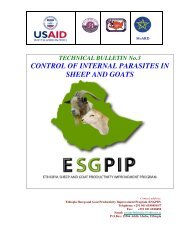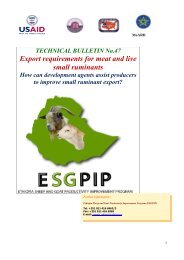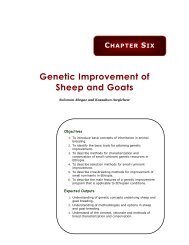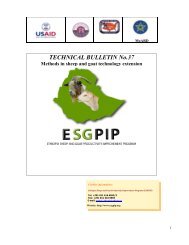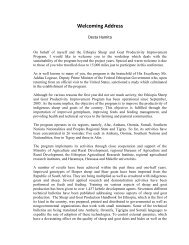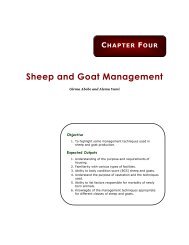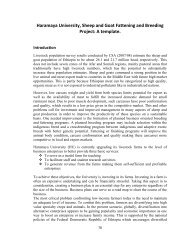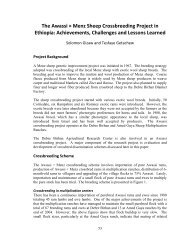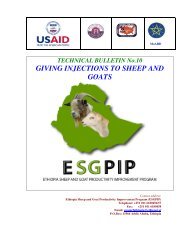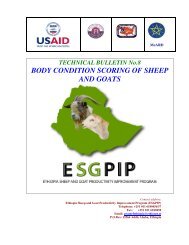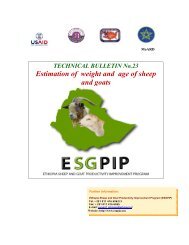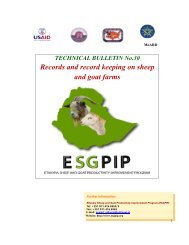TECHNICAL BULLETIN No.11 - esgpip
TECHNICAL BULLETIN No.11 - esgpip
TECHNICAL BULLETIN No.11 - esgpip
You also want an ePaper? Increase the reach of your titles
YUMPU automatically turns print PDFs into web optimized ePapers that Google loves.
Short term intensive fattening of sheep and goats before slaughter for<br />
rapid improvement in weight and condition and also producer incomes<br />
Prepared by: Alemu Yami Edited by: R.C. Merkel<br />
1. Introduction<br />
Current carcass yields of Ethiopian sheep and goats average 42%. Improving carcass yield<br />
results in more meat available for domestic consumption/export and directly increases<br />
producer incomes. Short term intensive feeding using locally available feedstuffs is a<br />
strategy that can be employed to increase animal live weights and subsequent carcass<br />
yields. Short-term intensive feeding prior to sale is economically more feasible than the<br />
current systems where animals are kept for long periods of time on maintenance level<br />
feeding. Cost benefit analyses of short term fattening compared to maintenance feeding for<br />
extended periods show that short term fattening can be a viable business venture.<br />
The domestic market remains to be the largest consumer of Sheep and goats in Ethiopia<br />
even though exports have been increasing over the past years. A fattening operation can be<br />
of various sizes. One can fatten one sheep or goat up to many hundreds or even thousands<br />
depending upon availability of capital, market access, etc. operations ranging from<br />
backyard to large scale fattening should be promoted. This can be done through provision<br />
of training, credit, fostering market access, etc.<br />
Fattening/Finishing involves intensive feeding of sheep and goats to slaughter weight with<br />
adequate finish (fat deposit) in feedlots. This targets the local market that has high demand<br />
for fat animals. The operation of large feedlots by export slaughter houses and independent<br />
feedlot operators (on-farm feedlots) is becoming feasible. The principal functions of such<br />
feedlot operations are to assemble large numbers of sheep and goats, often coming from<br />
different genetic and management backgrounds, and produce a product of acceptable<br />
standard. The following guidelines will serve these operations and also small farmers that<br />
want to fatten smaller numbers of sheep and goats. This will be the subject of this particular<br />
technical bulletin.<br />
2. Definition of terms<br />
• Feedlots: Enterprise in which animals are fed grain and other concentrates for<br />
usually 90-120 days to gain adequate muscle and finish (fat deposit) for slaughter.<br />
• Dry lot: Confined area in which animals are kept and fed intensively.<br />
• Fattening (finishing): Intensive feeding of highly nutritious feed to promote fast<br />
growth and fat deposition to achieve desired carcass quality.<br />
• Finished: Sheep and goats that have been fattened and are ready for slaughter.<br />
• Free-choice (ad libitum) feeding: Animals are given unlimited access to the feed<br />
and consume as much as they can.<br />
1



